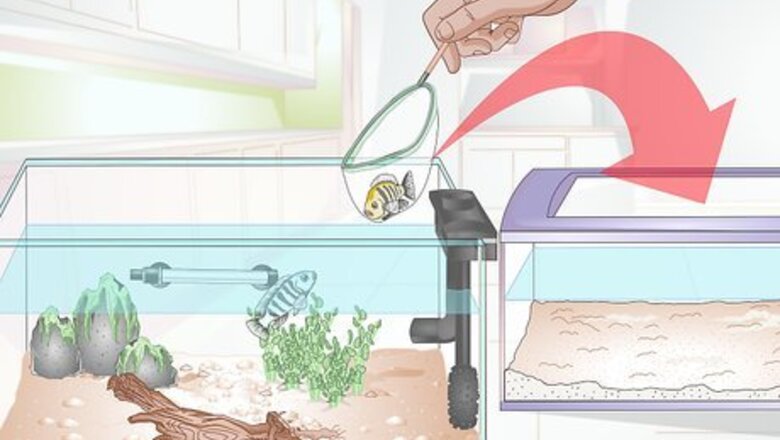
views
Draining the Water
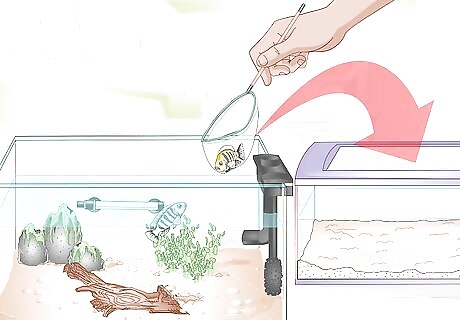
Transfer the fish out of your tank. You'll need to remove your fish and any other aquatic organisms before you can drain the water out of an aquarium. This requires great care, though, as fish tend to get frightened by this process and may become tangled in the nets. Choose the correct net size so that your largest fish will fit inside. Even if the nets are large enough, you'll still need to exercise caution so the fish don't get injured during the transfer. Use two fish nets to catch your fish within the tank. Hold one net steady and use the other to "herd" your fish into the stable net one at a time. Transfer the fish to a second tank large enough to hold them all. If you're having a hard time catching your fish, you can try draining off a little bit of the water. Working in a shallower tank will make it easier to herd and catch the fish.
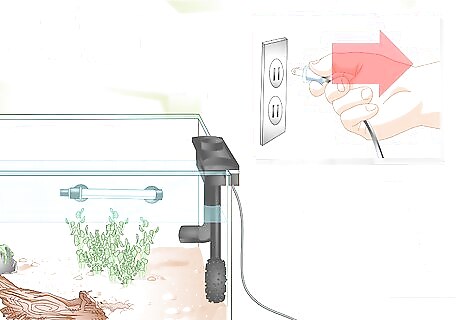
Disconnect all power sources from the tank. Once the fish have been removed from the tank you'll want to disconnect any power sources from the tank. Whether it's a filter, heater, or just an overhead light, you do not want any active electricity going to your tank when you start to empty the water. A plugged-in electricity source could cause electrocution if it gets wet. This can cause serious injuries which may even be fatal. Once you've unplugged each device you can move it out of the aquarium so that it is not in the way.
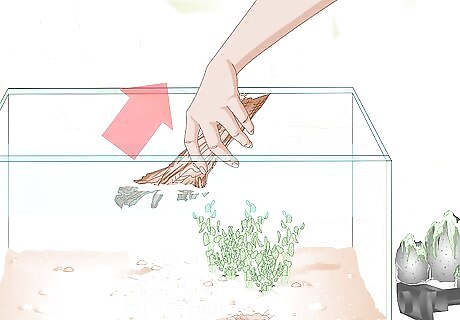
Remove all objects from the tank. Taking everything out of the tank before you drain the water will make it much easier to complete the draining process. These objects will need to get rinsed, so it may be best to do this near a sink if at all possible. Take out any artificial plants and decorations (like toys or sunken objects) out of the aquarium. Leave them in the sink to be cleaned. Doing this before you drain the water will allow any stirred-up debris to settle before you begin emptying the tank.
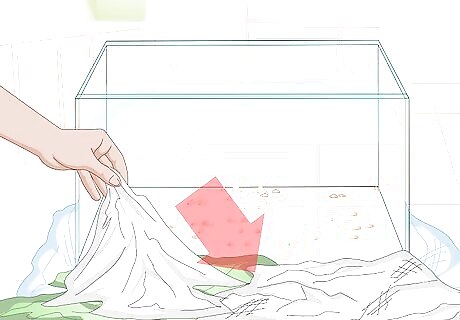
Lay down towels and mats or tarps. Whether you're new to aquarium maintenance or have been doing it for years, there's always a chance that something might spill. It's generally a good idea to lay down protective materials whenever you drain the tank or change the water to ensure that nothing in your home gets damaged. Arrange a few old towels on the floor around your aquarium. If you're really worried about spilling you can lay down tarps or mats underneath the towels for extra protection.
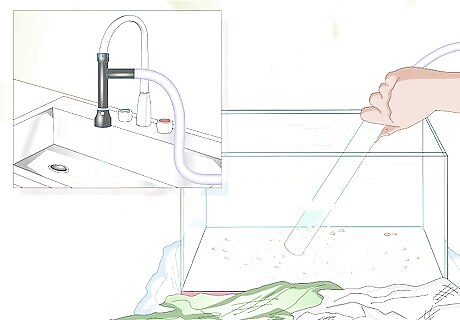
Drain the water out of your aquarium. There are two main methods of emptying an aquarium. The first is to siphon the water out using a hose. The second is to drain the water using a gravel cleaner that simultaneously drains water, such as The Python or Aqueon. If siphoning off the water with a hose, dip one end into the tank and begin filling the other end with water from a tap. Then stop filling the tap end and let it drain out; once water starts draining it will continue to draw water out of the tank. If using a gravel cleaner, activate the device and submerge the intake end all the way down into the gravel. You'll need to lift and reposition the device periodically as it drains, but it can be much easier and less messy than using a siphon hose.
Cleaning
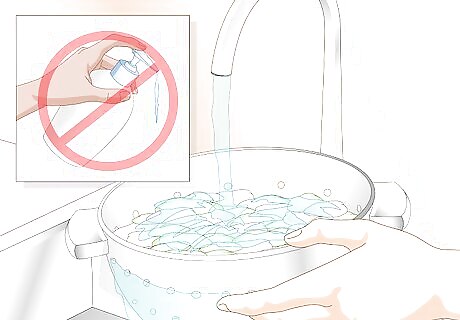
Wash the gravel from the substrate. If you used a gravel cleaner to drain the tank, your gravel should be clean enough to skip this step. However, if you used a siphon hose, you'll want to clean the gravel to remove debris like leftover food and organic waste. Collect the gravel in a colander. Make sure you only use this colander for cleaning your tank, as it will be too dirty to use for preparing food with. Rinse the gravel under clean, running tap water. You can use warm water but you should avoid using very hot water, as this will kill the healthy bacteria your fish rely on. Do not use soap or chemicals to clean the gravel, as these will also destroy the healthy bacteria that have colonized your tank.
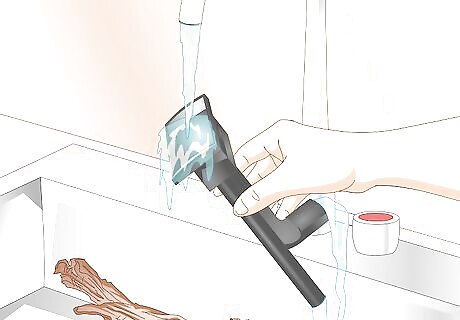
Rinse off the filter and any other tank objects. The filter in your tank traps a lot of organic debris, including leftover food and waste product. It's important to clean this equipment, but you need to do so carefully in order to avoid disrupting the bacterial colonies your fish depend on. If you use disposable filter media, simply discard the old cartridge and replace it with a new one. If you use permanent filter media, you'll need to rinse your filter media under clean, running tap water. You can use cool or warm water but you should avoid hot water, as this can damage the healthy bacteria inside the filter. Rinse any objects from the aquarium, such as toys and submerged artifacts, under clean, running tap water and set them aside.

Clean the glass walls of the tank. If you want to thoroughly clean the tank, you'll need to at least wipe down the walls inside of it. Built-up algae and other debris may need to be scraped off; otherwise, you should be able to use a sponge or special wipe to clean the glass. You can use an old credit card or ID card to scrape off algae that's stuck to the walls. Or, if you prefer, you can purchase a special tank scraper from a pet store to complete this task. Use clean paper towels or specialized cleaning wipes to scrub the inside of the tank. Do not use commercial cleaning products, as these will leave residual chemicals that can harm or even kill your aquatic organisms.
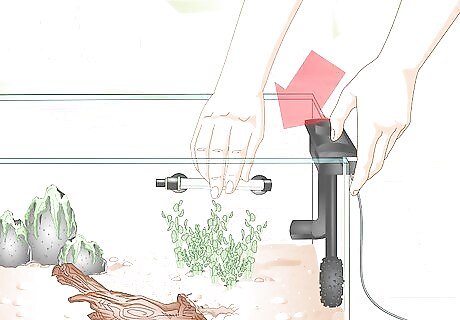
Replace the objects back in the tank. Once you're finished cleaning the tank you can begin replacing the objects back into it. Set up the gravel, then arrange your filter and any artificial plants or toys in the substrate. Plug the filter and heater back in and make sure the water is habitable before reintroducing your aquatic organisms.
Reassembling the Tank
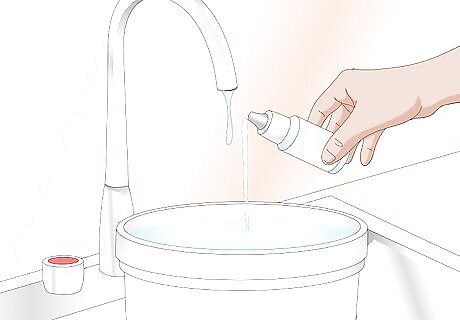
Dechlorinate enough tap water for your tank. If you have a home filtration system, your water may not need to be dechlorinated. If not, you'll need to dechlorinate your tap water before introducing your fish to the water. The process is fairly simple, and there are two main methods of dechlorinating your water. You can dechlorinate your water naturally by leaving it out in an opened container for several days. Over time the chlorine will evaporate out of the container, leaving only the now-dechlorinated water. You can dechlorinate water quickly and easily by adding a few drops of dechlorination solution from your local pet store. Follow the instructions on the label to ensure that your water levels are safe for fish.
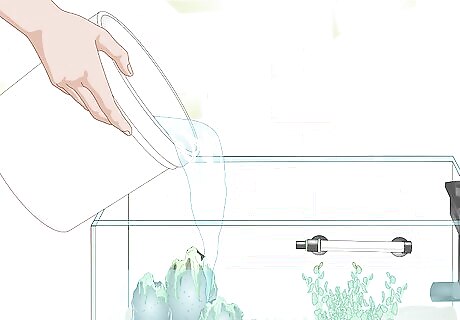
Refill a freshwater tank. A freshwater tank is somewhat easier to refill than a marine aquarium. You won't need to do much to the water, other than dechlorinating it and ensuring that it's the right temperature (if your aquatic organisms require a specific temperature range). Once you've dechlorinated enough water, you can simply pour it into the clean tank. If your fish require a specific temperature range, you'll need to monitor the temperature of the clean water before adding your fish.
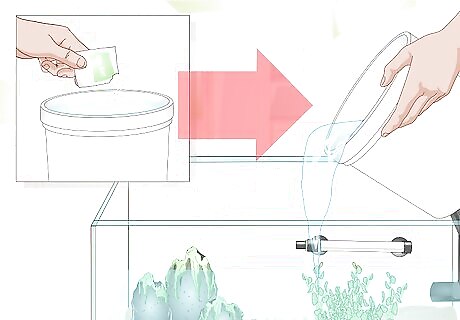
Set up a saltwater tank. A saltwater tank can be a bit more work than a freshwater tank, but with a little patience it's easily manageable. The biggest difference between saltwater and freshwater aquariums is the need to salinate the water before adding it to the tank. Mix a new batch of saltwater by combining your preferred commercial salt mix and the right amount of dechlorinated tap water. The specific gravity of your saltwater should measure 1.025. Pour the prepared saltwater into the tank and fill it to your desired level. Be careful not to disturb any plants or live rocks at the bottom of the tank. If your aquatic organisms require a specific temperature range you'll need to make sure the water is an acceptable temperature before reintroducing your fish.
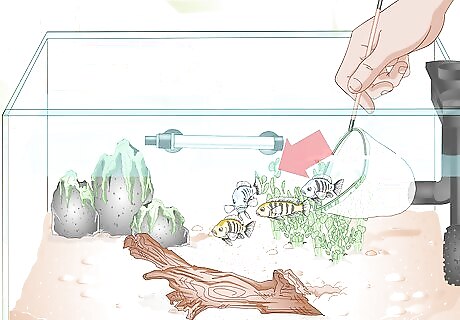
Reintroduce your aquatic organisms. Once your tank is refilled and the temperature is correct (if relevant), you're ready to reintroduce your aquatic organisms. You can either use nets to scoop them out of their secondary container and into the clean tank, or you can carefully and gently pour them with the water from their container into the tank. Make sure the filter and heater (if relevant) are working and have prepared the water before you reintroduce your aquatic organisms. Scooping and transferring them may be less stressful for the fish than pouring them back in.




















Comments
0 comment